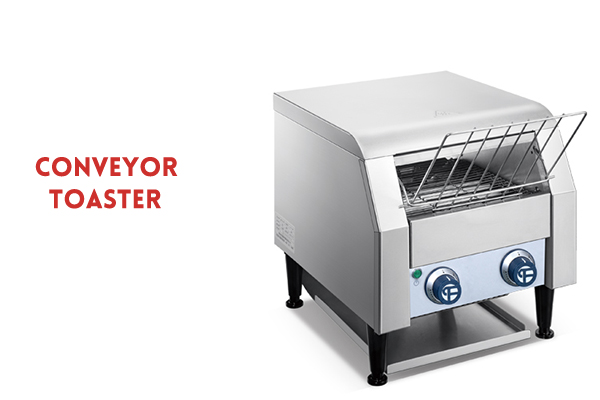Struggling with conveyor toaster malfunctions in your commercial kitchen? Discover practical troubleshooting steps for electrical faults. Learn essential maintenance practices to ensure peak performance of your commercial conveyor toaster equipment.
How to Troubleshoot The Conveyor Toaster | A Complete Guide
As the demands of commercial kitchens, such as bakeries and bustling cafés, continue to grow, the conveyor toaster has become a cornerstone of efficiency, handling large volumes of bread slices and bagels with ease. However, heavy daily use and lack of proper maintenance can lead to unexpected malfunctions. In this article, we'll explore common issues and their solutions, backed by our conveyor toaster model, to help you quickly restore your equipment to optimal performance.
Why Do Conveyor Toasters Toast Unevenly?
Toast Color Too Light or Too Dark
The toast color is influenced by several factors, including incorrect temperature settings, voltage instability, or aging heating elements. To resolve this, first adjust the 'browning control knob' to the desired setting, such as a lighter or darker shade. Next, verify that the power supply voltage matches the equipment specifications, like 220V or 380V; voltage fluctuations can cause uneven heating. If the heating elements are not functioning, it might be due to long-term use or carbon buildup from improper cleaning. In such cases, contact the manufacturer for replacement.
Incomplete or Uneven Toasting
This issue can stem from a misaligned conveyor belt, partial damage to the heating elements, or failure to preheat the device. Begin by ensuring the conveyor toaster has been preheated for 15-20 minutes prior to use. Then, inspect whether the heating element reflector is blocked by crumbs. Regular cleaning with a stiff brush is recommended. Finally, check the position of the conveyor belt. If it is misaligned, the bread slices will not be centered, leading to uneven toasting.
Conveyor Belt Operational Issues
Conveyor Belt Slippage or Jamming
Conveyor belt slippage or jamming typically results from insufficient tension, worn transmission rollers, or obstructions. If your equipment uses a weight-based tensioning system, you can increase the weight to tighten the belt. For hydraulic tensioning devices, adjust the travel distance accordingly. Second, inspect the transmission components. If the roller surface is contaminated with grease or burnt residues, clean it with a non-corrosive cleaner, ensuring the equipment is powered off during this process. If the roller covering is severely worn, professional hot-melt repair or replacement of the roller will be necessary.
Conveyor Belt Misalignment
Misalignment of the conveyor belt can be caused by improperly installed support rollers, an uneven equipment frame, or uneven loading. Start by adjusting the angle of the support rollers. For short conveyor belts, slightly adjust the support rollers on the side where the belt is running off in the direction of the belt movement. Then, use a level to check the machine's alignment, ensuring the frame is perpendicular to the ground. Lastly, ensure that the load is evenly distributed. Avoid placing too many bread slices in a single batch, as this can lead to uneven weight distribution.

Equipment Overheating and Tripping
Frequent Circuit Breaker Tripping
Circuit breaker tripping is often due to short circuits, grounding faults, or power overload. First, inspect the power cord for damage and check if internal electrical connections are loose. This task should be performed by a qualified electrician. Also, confirm that the equipment's rated power matches the circuit breaker's capacity. For instance, a 10A device should not be used with a 5A circuit breaker.
Cooling Fan Failure
Cooling fan failure can result from clogged vents or a faulty motor. Clean the cooling fan vents monthly using a vacuum cleaner to remove dust buildup, especially for FSCT0404E models. If the fan has stopped rotating, the motor may need replacing, or you can contact the manufacturer for repairs.
Daily Maintenance and Preventive Measures
Daily Cleaning
Each day, clean the crumb tray and bread collection tray to prevent residue carbonization, which can cause odors or fire hazards. Use a non-abrasive cleaner to wipe the conveyor belt and heating element reflector, avoiding scratches from hard objects.
Regular Inspections
Monthly, check the lubrication of the drive gears. Some models are permanently lubricated and require no additional oiling. Quarterly, test the temperature sensor and control system to ensure accurate toasting temperatures.
In the commercial kitchen equipment sector, understanding these aspects of conveyor toasters can significantly enhance their operational life and efficiency in commercial kitchen settings.

Since Shinelong was established in Guangzhou in 2008, we have made great strides in the fields of commercial kitchen planning and kitchen equipment manufacturing.
IF YOU HAVE ANY QUESTION,PLEASE CONTACT US.
WhatsApp: +8618902337180
WeChat: +8618924185248
Telephone: +8618924185248
Fax: +86 20 34709972
Email: info@chinashinelong.com
After-Sales Contact
Telephone: +8618998818517
Email: service@chinashinelong.com
Add: No. 1 Headquarters Center, Tian An Hi-tech Ecological Park, Panyu Avenue, Guangzhou, China.


















